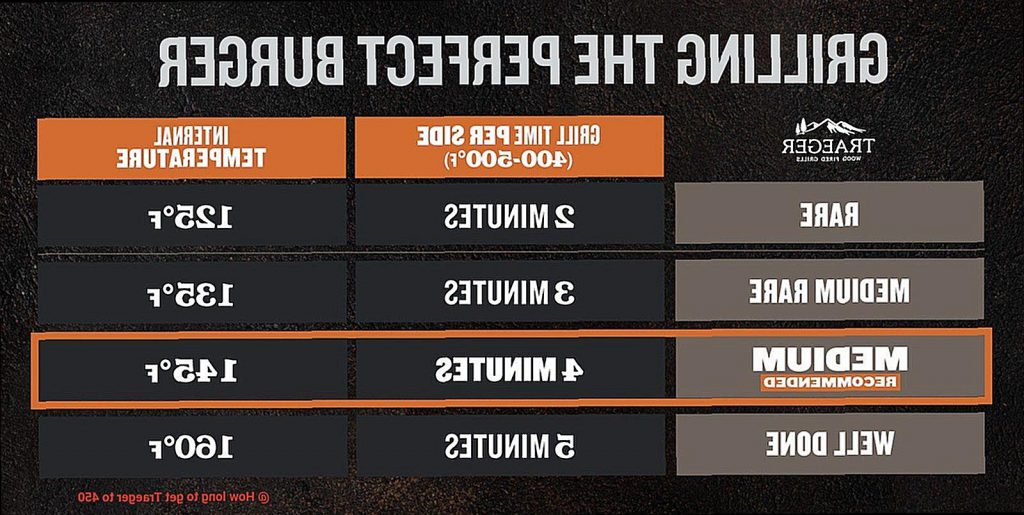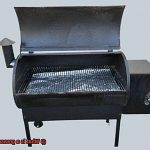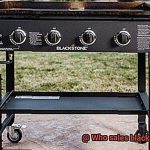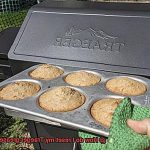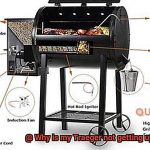Are you a die-hard meat lover who can’t resist the tantalizing smoky flavor of barbecue? Then, owning a Traeger grill is an absolute must-have for you. This versatile cooking appliance is perfect for grilling, smoking, and roasting, giving your food that perfect smoky aroma.
But have you ever wondered how long it takes to get your Traeger grill to reach the optimum temperature of 450°F? It’s a crucial question that every Traeger enthusiast needs to know the answer to. The ideal cooking temperature of 450°F is perfect for searing steaks, cooking chicken, and even roasting vegetables in no time.
In this article, we’ll dive deep into how long it takes to get Traeger to 450°F. We’ll also share some tips and tricks to optimize your cooking experience further. From initial setup and type of wood pellets to outside temperature, we’ll explore all the main factors that affect the heating process of your Traeger grill.
So whether you’re a seasoned grill master or an amateur cook looking to up your game, keep reading. We’ve got everything you need to know about how long it takes to get Traeger to 450°F and create deliciously flavorful food for yourself, friends, and family.
Contents
What is a Traeger Grill?
Invented by Joe Traeger in 1985, this type of wood pellet grill has become a popular choice for backyard cookouts and professional kitchens alike.
So, what exactly is a Traeger grill? It works by using wood pellets as fuel to heat the grill, which are fed into the grill through an auger and ignited by a hot rod. The heat then cooks the food on the grates above, imparting that smoky flavor that many people love.
One of the standout features of Traeger grills is their digital controller, which monitors the temperature and adjusts the fuel and air supply to maintain the desired temperature. This means that even novice grillers can achieve perfect results every time. And with a range of sizes and models available, from small portable units to large commercial grills, there’s something for everyone.
But how long does it take for a Traeger grill to reach 450 degrees Fahrenheit? It can vary depending on factors such as outside temperature and the type of wood pellets being used, but in general, it takes anywhere from 10 to 20 minutes. To speed up the process, make sure you’re using high-quality wood pellets designed for quick ignition and optimal heat output. And always preheat your Traeger grill for at least 15 minutes before putting any food on it.
Speaking of food, Traeger grills can be used to cook just about anything. Meats, vegetables, and even baked goods can all be prepared on a Traeger grill, giving you endless options for delicious meals.
Factors that Affect the Time it Takes to Preheat a Traeger Grill
Get ready to fire up your Traeger grill and cook some mouth-watering meals. However, before you start, it’s important to keep in mind the various factors that can impact the time it takes to preheat your grill. As an expert on this topic, I’m here to guide you through essential factors that can affect the preheating time of your Traeger grill.
Firstly, let’s talk about the outside temperature. This factor plays a significant role in how long it takes to preheat your grill. On a hot summer day, your Traeger grill will heat up much faster than on a cold winter day. Cold weather causes grills to lose heat to their surroundings, and this slows down the preheating process. Therefore, it’s crucial to check the outside temperature before you start preheating your grill.
Next, consider the size of your Traeger grill. Larger grills will require more time to preheat as there is more space to heat up. If you’re using hardwood pellets, they burn hotter and produce less ash than softwood pellets, resulting in optimal preheating time.
The starting temperature of your Traeger grill also affects how long it takes to preheat. If your grill is warm from previous use, it will take less time to reach 450°F than starting from a completely cold grill. However, make sure you let your grill fully cool down before starting a new cook.
Lastly, the amount of food you’re cooking can impact the preheating time. If you’re cooking a small amount of food, your grill will heat up faster than if you were cooking a large amount. This is because less food impedes heat and air flow.
How Long Does it Take to Get a Traeger Grill Up to 450 Degrees Fahrenheit?
Traeger grills use wood pellets as fuel, which are fed into a firepot by an auger. The firepot ignites the pellets, and the heat and smoke are circulated throughout the grill by a fan. Temperature is controlled by adjusting the amount of pellets fed into the firepot and the speed of the fan.
Now, let’s talk about reaching that ideal temperature. Several factors affect how long it takes for your Traeger grill to hit 450 degrees Fahrenheit. These include the type of pellets used, the outside temperature, and the starting temperature of the grill.
On average, it takes around 15-20 minutes for a Traeger grill to reach 450 degrees Fahrenheit from a cold start. To speed up this process, preheat your grill or use high-quality pellets made from hardwoods like hickory or mesquite.
It’s important to note that while Traeger grills have consistent temperature control, slight variations in temperature may occur depending on the model of grill and environmental factors. To ensure that your food has reached a safe internal temperature before serving, always use an internal meat thermometer.
In summary, here are some key takeaways for getting your Traeger grill up to 450 degrees Fahrenheit:
- Traeger grills use wood pellets for fuel and have consistent temperature control.
- On average, it takes about 15-20 minutes for a Traeger grill to reach 450 degrees Fahrenheit from a cold start.
- Preheating your grill or using high-quality hardwood pellets can speed up this process.
- Always use an internal meat thermometer to ensure safe internal temperatures before serving.
Tips for Quickly Preheating Your Traeger Grill
Grilling is a favorite pastime for many, and nothing beats the smoky flavor of perfectly cooked food from your Traeger grill. However, preheating your grill is crucial for achieving consistent results. If you’re short on time and need to quickly preheat your Traeger grill to 450 degrees Fahrenheit, here are some expert tips to help you out.
Clean Your Grill
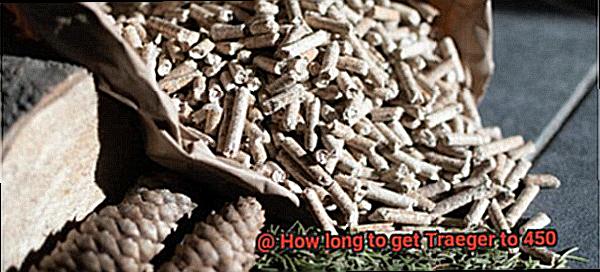
Before starting your Traeger grill, ensure it’s free from any debris or ashes. Clean the grates with a grill brush or scraper, removing any excess ash. This will help heat up the grill evenly and quickly.
Use High-Quality Pellets
Using high-quality pellets that ignite quickly and produce optimal heat output can speed up the preheating process. Fill the hopper with enough pellets to reach at least half capacity, ensuring there’s enough fuel to achieve and maintain the desired temperature.
Turn Up the Heat
After cleaning and filling up the hopper, turn on your Traeger grill and set it to the highest temperature setting at 450 degrees Fahrenheit. Allow time for it to heat up, which could take 10-20 minutes depending on your model.
Leave the Lid Open
Leaving the lid open while heating up your Traeger grill enables more air to circulate, increasing the temperature more quickly. This is an excellent trick if you’re in a hurry and need to get your grill up to temperature fast.
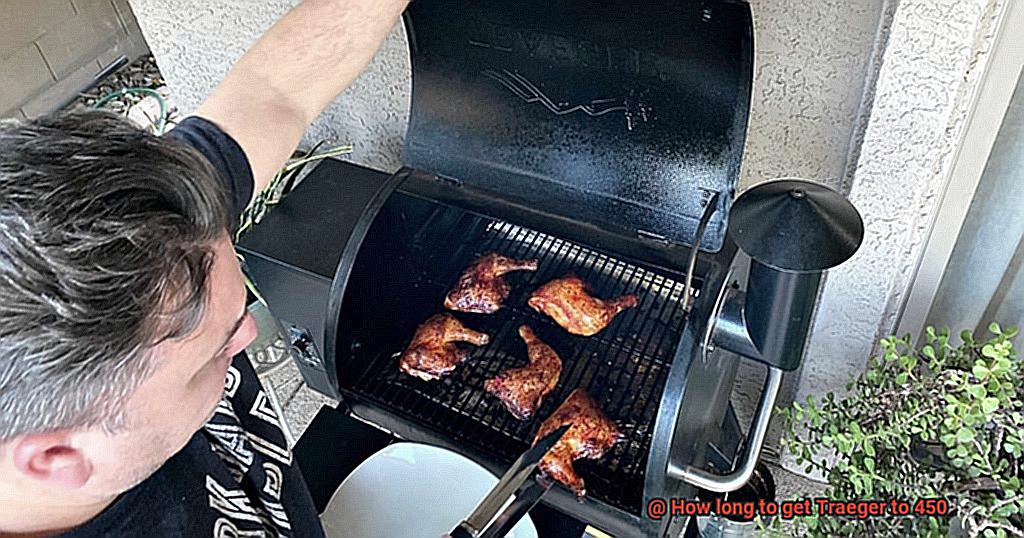
Use a Thermal Blanket or Insulation Cover
Using a thermal blanket or insulation cover for your Traeger grill helps trap heat inside, allowing it to reach higher temperatures faster. It’s especially useful during colder months or when grilling in windy conditions.
The Benefits of Preheating Your Traeger Grill
Preheating your Traeger grill has a plethora of benefits that you wouldn’t want to miss out on. For starters, it creates a non-stick surface that prevents your food from sticking to the grates. When you preheat your grill, it allows the grates to expand and contract, creating a smooth surface that makes flipping and removing food a breeze. Say goodbye to sticky messes and ruined meals.
Preheating your Traeger grill also helps lock in the flavors of your food. When you cook on a cold grill, it takes longer to cook, which can cause the flavors to evaporate. However, when you preheat your grill, it cooks quickly, locking in the flavors and juices. This results in a more flavorful and delicious meal that will leave your taste buds craving for more.
In addition to these benefits, preheating your Traeger grill also helps reduce cooking time significantly. You don’t have to wait for the grill to heat up while your stomach grumbles impatiently. Preheating allows you to start cooking immediately and ensures that your food is cooked to perfection.
So, what are some expert tips for preheating your Traeger grill? Start by cleaning the grill thoroughly and using high-quality pellets that burn efficiently. Turn up the heat to 450 degrees Fahrenheit and leave the lid open for about 10-15 minutes before putting your food on the grill. Using a thermal blanket or insulation cover can also help speed up the preheating process.
Troubleshooting Common Problems When Preheating Your Traeger Grill
I am here to help you get your grill up to temperature and cooking like a pro. Preheating your grill is a crucial step in achieving mouth-watering, perfectly cooked meals. However, several common issues can hinder this process and prevent you from reaching your desired temperature or achieving consistent results.
One of the most common problems when preheating your Traeger grill is slow heating. If your grill takes too long to reach the desired temperature, it could be due to a clogged firepot or a malfunctioning igniter. To tackle this problem, start by checking if the firepot is clean and free from any debris that may be blocking the airflow. Next, ensure that the igniter is working correctly. If neither of these solutions works, consider replacing the igniter or contacting Traeger customer support for further assistance.
Temperature fluctuation is another frequent issue that can ruin even the most carefully crafted meals. A dirty temperature sensor or malfunctioning auger motor may cause this problem. To fix this issue, clean your temperature sensor to ensure it’s functioning correctly and check if your auger motor is working correctly and isn’t clogged with debris. If these solutions do not work, consider replacing one or both of these components.
In addition to these common problems, there are a few other tips that can help you preheat your Traeger grill like a pro. Firstly, ensure that your hopper is full of pellets before preheating. This will ensure that the auger has enough fuel to feed into the firepot and maintain the desired temperature. Secondly, avoid opening the lid too often during preheating as this can cause heat loss and slow down the process.
Pzi2glPEHnk” >
Conclusion
In conclusion, preheating your Traeger grill is a critical step in achieving perfectly cooked, mouth-watering meals. The temperature sweet spot for searing steaks, cooking chicken, and roasting vegetables is 450 degrees Fahrenheit. However, the time it takes to get your Traeger grill up to this temperature can vary depending on several factors.
Factors such as outside temperature, grill size, wood pellet type, and food quantity can all impact preheating time. On average, it takes around 15-20 minutes for a Traeger grill to reach 450 degrees Fahrenheit from a cold start.
To expedite the preheating process, use high-quality hardwood pellets designed for quick ignition and optimal heat output. Additionally, make sure to preheat your grill for at least 15 minutes before putting any food on it.
Preheating your Traeger grill has numerous benefits that include creating a non-stick surface that prevents food from sticking to the grates and locking in the flavors of your food. It also significantly reduces cooking time and ensures even cooking.
If you encounter common problems when preheating your Traeger grill such as slow heating or temperature fluctuation, there are several troubleshooting tips you can try. Cleaning the firepot and temperature sensor and ensuring that your hopper is full of pellets can help resolve these issues.

